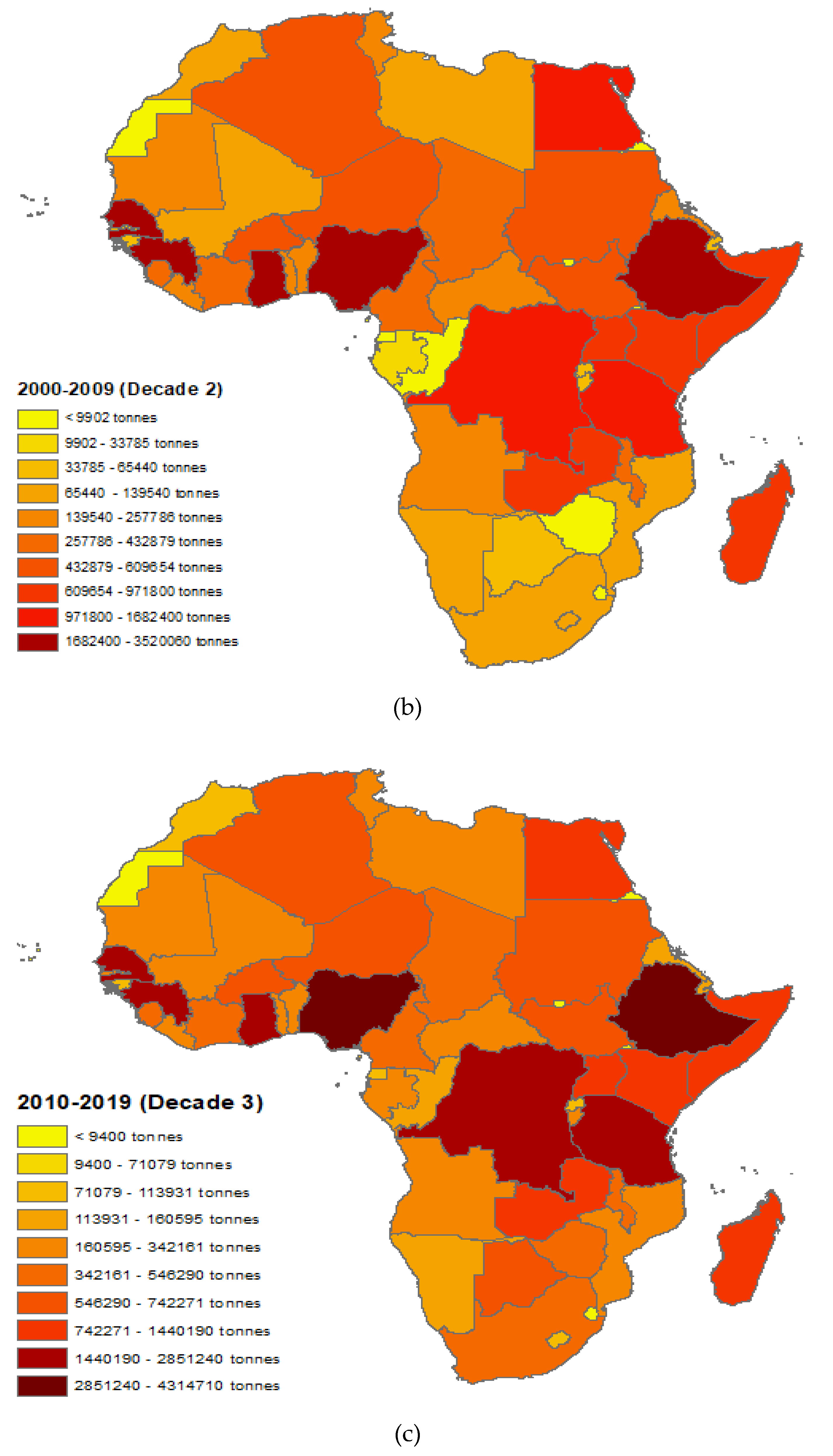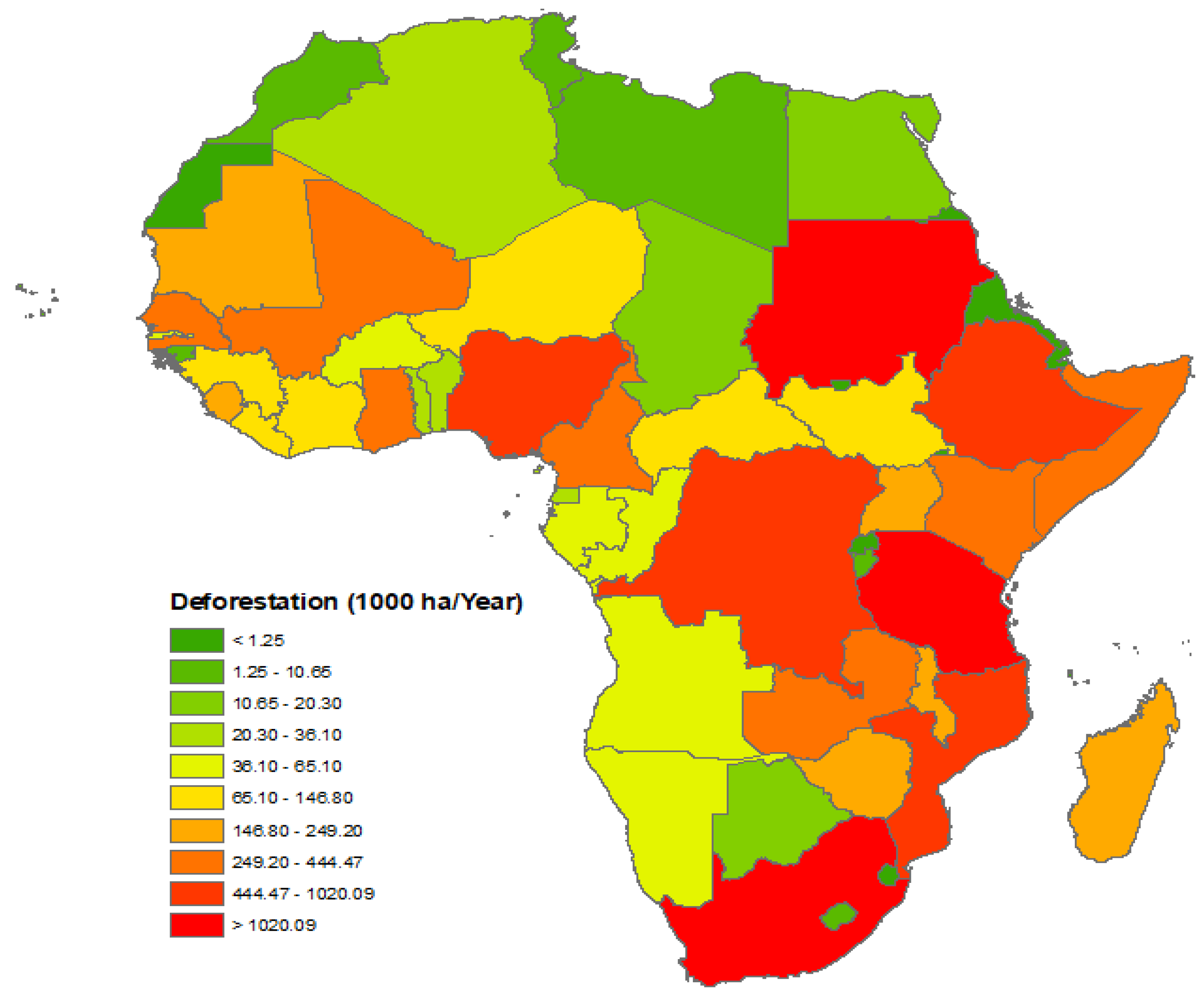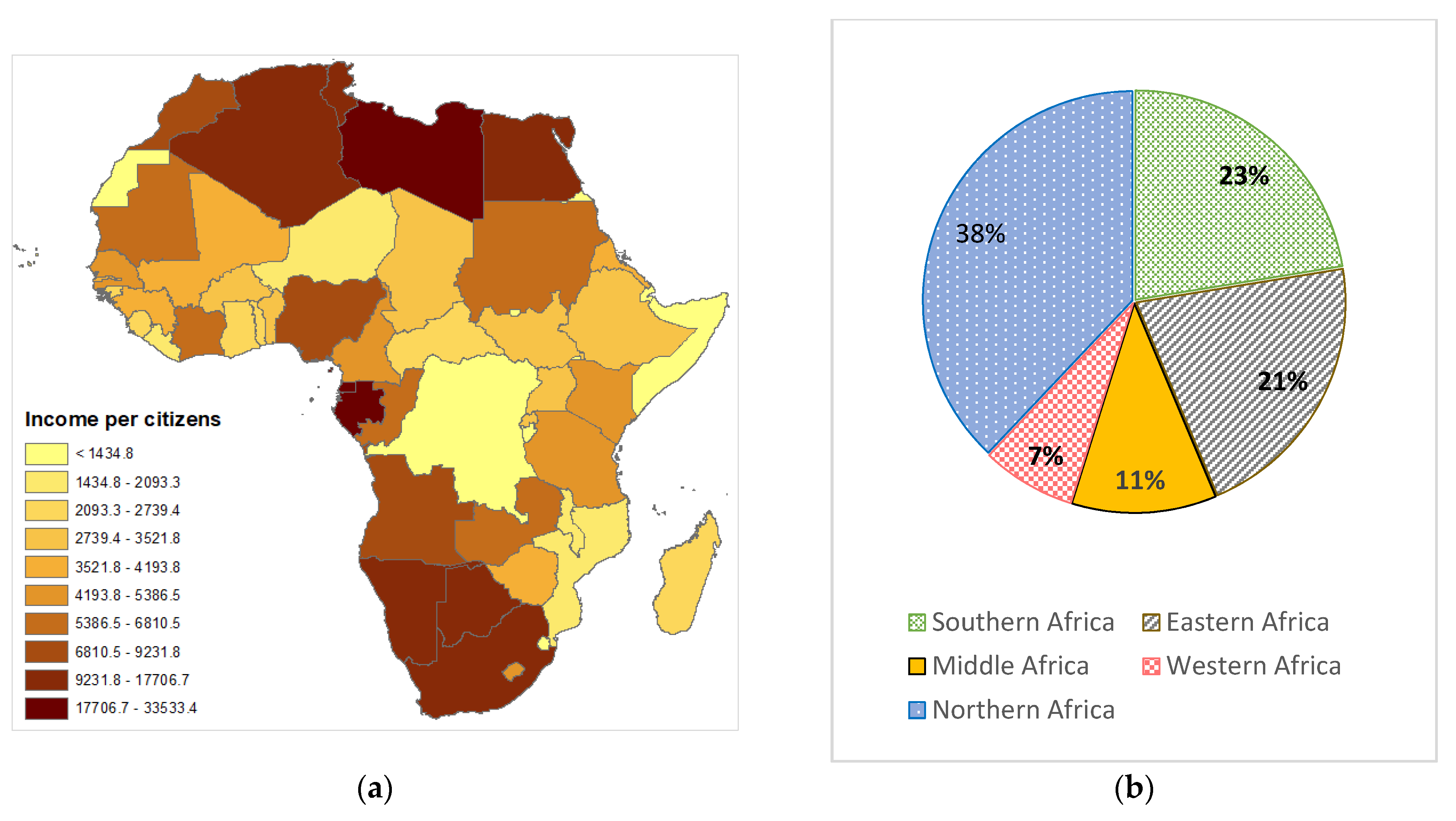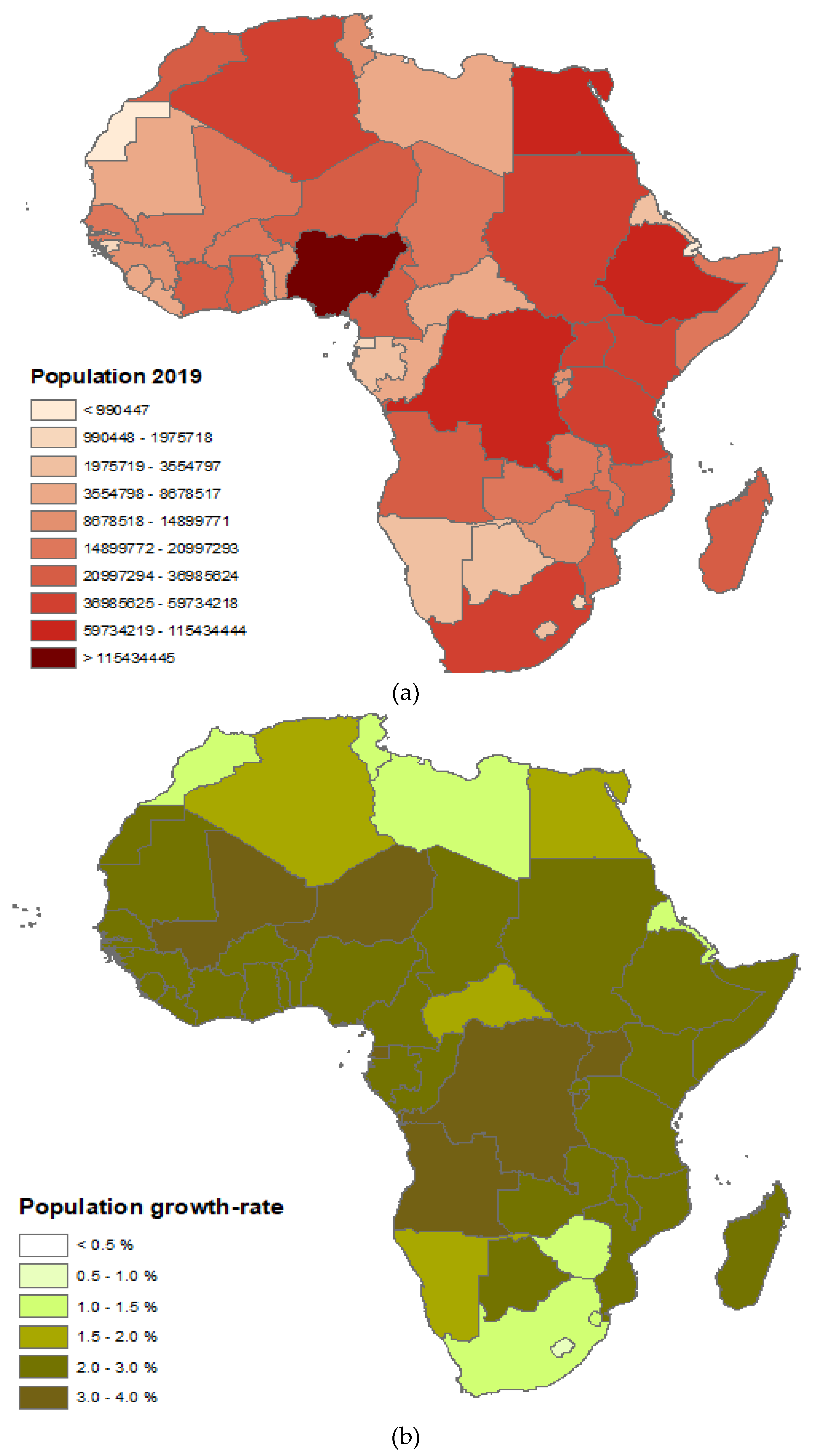Socio-Economic Analysis of Wood Charcoal Production as a Significant Output of Forest Bioeconomy in Africa
Abstract
1. Introduction
2. Materials and Methods
2.1. Description of Study Area
2.2. Wood Charcoal Production and Markets in Africa
2.3. Data Collection
2.4. Data Analysis
3. Results and Discussion
3.1. Wood Charcoal Production
3.2. Relationships Between Wood Charcoal Production, Income and Forest Area Change (Deforestation Rate)
3.3. Population, Export Quantity and Wood Charcoal Production Nexus
3.4. Correlation Matrix between Wood Charcoal Production, Environment and Socioeconomic Factors
3.5. Dynamics in Wood Charcoal Production and Consumption
3.6. Implications of the Wood Charcoal Production
4. Conclusions
Supplementary Materials
Author Contributions
Funding
Institutional Review Board Statement
Informed Consent Statement
Data Availability Statement
Acknowledgments
Conflicts of Interest
References
- Demirbas, A. Carbonization ranking of selected biomass for charcoal, liquid and gaseous products. Energy Convers. Manag. 2001, 42, 1229–1238. [Google Scholar] [CrossRef]
- Deforce, K.; Boeren, I.; Adriaenssens, S.; Bastiaens, J.; de Keersmaeker, L.; Haneca, K. Selective woodland exploitation for charcoal production. A detailed analysis of charcoal kiln remains (ca. 1300–1900 AD) from Zoersel (Northern Belgium). J. Archaeol. Sci. 2013, 40, 681–689. [Google Scholar] [CrossRef]
- Alcaide, M.Á.M.; Torti, J.L.S.; Peña, L.Z. Lighting the dark: Wood charcoal analysis from Cueva de Nerja (Málaga, Spain) as a tool to explore the context of Palaeolithic rock art. Comptes Rendus Palevol 2015, 14, 411–422. [Google Scholar] [CrossRef]
- Jekayinfa, S.O.; Orisaleye, J.I.; Pecenka, R. An Assessment of Potential Resources for Biomass Energy in Nigeria. Resources 2020, 9, 92. [Google Scholar] [CrossRef]
- Mensah, K.E.; Damnyag, L.; Kwabena, S.N. Analysis of charcoal production with recent developments in Sub-Sahara Africa: A review. Afr. Geogr. Rev. 2020. [Google Scholar] [CrossRef]
- Mwampamba, T.H.; Ghilardi, A.; Sander, K.; Chaix, K.J. Dispelling common misconceptions to improve attitudes and policy outlook on charcoal in developing countries. Energy Sustain. Develop. 2013, 17, 75–85. [Google Scholar] [CrossRef]
- Ngahane, M.B.H.; Afane, Z.E.; Chebu, C. Effects of cooking fuel smoke on respiratory symptoms and lung function in semi-rural women in Cameroon. Int. J. Occup. Environ. Health 2015, 21, 61–65. [Google Scholar] [CrossRef] [PubMed]
- Bede-Ojimadu, O.; Orisakwe, O.E. Exposure to Wood Smoke and Associated Health Effects in Sub-Saharan Africa: A Systematic Review. Ann. Glob. Health 2020, 86, 1–27. [Google Scholar] [CrossRef] [PubMed]
- Okello, G.; Devereux, G.; Semple, S. Women and girls in resource-poor countries experience much greater exposure to household air pollutants than men: Results from Uganda and Ethiopia. Environ. Int. 2018, 119, 429–437. [Google Scholar] [CrossRef]
- Zulu, L.C. The forbidden fuel: Charcoal, urban woodfuel demand and supply dynamics, community forest management and woodfuel policy in Malawi. Energy Policy 2020, 38, 3717–3730. [Google Scholar] [CrossRef]
- Zulu, L.C.; Richardson, R.B. Charcoal, livelihoods, and poverty reduction: Evidence from Sub-Saharan Africa. Energy Sustain. Dev. 2013, 17, 127–137. [Google Scholar] [CrossRef]
- Ankona, E.; Multanen, V.; Nisnevitch, M.; Billig, M.; Anker, Y. Investigation of pyrolysis kinetics and gaseous compounds emitted during charcoal production from woods commonly used in the Eastern Mediterranean. Biofuelsbioprod. Bioref. 2021. [Google Scholar] [CrossRef]
- UN-DESA. Energy Statistics Yearbook; United Nations, Department of Economic and Social Affairs: New York, NY, USA, 2019; Available online: https://digitallibrary.un.org/record/3846782 (accessed on 15 January 2021).
- FAOSTAT Comparative Data. 2019. Available online: http://www.fao.org/faostat/en/#compare (accessed on 15 January 2021).
- FAOSTAT and Energy Statistics Database; United Nations Statistics Division, 2019; Available online: http://www.fao.org/faostat/en/#home (accessed on 9 December 2020).
- Nabukalu, C.; Gieré, R. Charcoal as an Energy Resource: Global Trade, Production and Socioeconomic Practices Observed in Uganda. Resources 2019, 8, 183. [Google Scholar] [CrossRef]
- Bamwesigye, D.; Kupec, P.; Chekuimo, G.; Pavlis, J.; Asamoah, O.; Samuel, A.; Darkwah, S.A.; Hlaváčková, P. Charcoal and Wood Biomass Utilization in Uganda: The Socioeconomic and Environmental Dynamics and Implications. Sustainability 2020, 12, 8337. [Google Scholar] [CrossRef]
- Nkengfack, H.; Fotio, H.K. Anthropogenic CO2 emission and climate change in the Congo basin countries. Eur. J. Comp. Econs. 2020, 17, 205–227. [Google Scholar]
- Ahrends, A.; Burgess, N.D.; Milledge, S.A.H.; Bulling, M.T.; Fisher, B.; Smart, J.C.R. Predictable waves of sequential forest degradation and biodiversity loss spreading from an African city. Proc. Natl. Acad. Sci. USA 2010, 107, 14556–14561. [Google Scholar] [CrossRef] [PubMed]
- Habel, J.C.; Zamora, C.; Rödder, D.; Teucher, M.; Cuadros Casanova, I.; Fischer, C. Using indicator species to detect high quality habitats in an East African forest biodiversity hotspot. Biodiv. Conserv. 2021, 30, 903–915. [Google Scholar] [CrossRef]
- Massuque, J.; De Assis, M.R.; Loureiro, B.A.; Matavel, C.; Trugilho, P.F. Influence of lignin on wood carbonization and charcoal properties of Miombo woodland native species. Eur. J. Wood Prod. 2021. [Google Scholar] [CrossRef]
- Agyei, F.K.; Hansen, C.P.; Acheampong, E. Forestry officials don’t have any land or rights here: Authority of politico-legal institutions along Ghana’s charcoal commodity chain. J. Rural Stud. 2019, 72, 264–272. [Google Scholar] [CrossRef]
- Sola, P.; Schure, J.; Atyi, R.E.; Gumoo, D.; Okeyo, I.; AwoNo, A. Woodfuel policies and practices in selected countries in Sub-Saharan Africa—A critical review. Bois For. Des Trop. 2019, 340, 27–41. [Google Scholar] [CrossRef]
- Wassie, Y.T.; Adaramola, M.S. Potential environmental impacts of small-scale renewable energy technologies in East Africa: A systematic review of the evidence. Renew. Sustain. Energy Rev. 2019, 111, 377–391. [Google Scholar] [CrossRef]
- Chidumayo, E.N. Long term impacts of crop cultivation and tree shading on Piliostigma thonningii (Schumach) Milne-Redhead population, growth and biomass production after charcoal production in central Zambia. Glob. Ecol. Conserv. 2018, 13, e00373. [Google Scholar] [CrossRef]
- World Bank Groups Database on Literacy Rate. 2020. Available online: https://data.worldbank.org/indicator/SE.ADT.LITR.ZS (accessed on 21 February 2021).
- Ndegwa, G.; Anhuf, D.; Nehren, U.; Ghilardi, A.; Iiyama, M. Charcoal contribution to wealth accumulation at different scales of production among the rural population of Mutomo District in Kenya. Energy Sustain. Develop. 2016, 33, 167–175. [Google Scholar] [CrossRef]
- Marfo, E.; Owusu, F.W.; Damnyag, L.; Adeyiga, G.; Karambiri, M. Domestic Timber Markets and Trade in Ghana; Tropenbos International: Wageningen, The Netherlands, 2016. [Google Scholar]
- United Nations Statistics Division, UNdata. Wood Charcoal Report in African Countries: UNdata. 2019. Available online: https://data.un.org/ (accessed on 11 January 2021).
- World Bank. World Development Indicators 2019. Available online: http://data.worldbank.org/datacatalog (accessed on 27 December 2020).
- World Income Inequalities Databases (WID). 2019. Available online: https://wid.world/ (accessed on 4 January 2021).
- Nguyen, L.H.; Holmes, S. Ten quick tips for effective dimensionality reduction. PLoS Comput. Biol. 2019, 15, e1006907. [Google Scholar] [CrossRef] [PubMed]
- Ter Braak, C.J.F.; Smilauer, P. Canoco 5, Windows Release (5.12). Software for Multivariate Data Exploration, Testing, and Summarization; Biometris, Plant Research International: Wageningen, The Netherlands, 2012. [Google Scholar]
- TIBCO Software Inc. Statistica (Data Analysis Software System); Version 13.3; Statsoft Inc.: Tulsa, OK, USA, 2017. [Google Scholar]
- ESRI. ArcGIS Desktop: Release 10; Environmental Systems Research Institute: Redlands, CA, USA, 2019. [Google Scholar]
- Downward, G.S.; van der Zwaag, H.P.; Simons, L. Occupational exposure to indoor air pollution among bakery workers in Ethiopia: A comparison of electric and biomass cookstoves. Environ Pollut. 2018, 233, 690–697. [Google Scholar] [CrossRef] [PubMed]
- Anang, B.T.; Akuriba, M.A.; Alerigesane, A.A. Charcoal production in Gushegu District, Northern Region, Ghana: Lessons for sustainable forest management. Int. J. Environ. Sci. 2011, 1, 1944–1953. [Google Scholar]
- Wurster, K.W. Management Matter? Effects of Charcoal Production Management on Woodland Regeneration in Senegal. Ph.D. Dissertation, University of Maryland, Maryland, USA, 2010; p. 10. Available online: http://drum.lib.umd.edu/bitstream/1903/10307/1/Wurster_umd_0117E_11139.pdf (accessed on 3 February 2021).
- Rahma, M.M. Increase in deforestation: A key challenge to household charcoal supply—A case of Tanga urban, Tanzania. Eur. J. Soc. Sci. Stud. 2017, 2, 132–152. [Google Scholar]
- Sedano, F.; Silva, J.A.; Machoco, R.; Meque, C.H.; Sitoe, A.; Ribeiro, N.; Anderson, K.; Ombe, Z.O.; Baule, S.H.; Tucker, C.J. The impact of charcoal production on forest degradation: A case study in Tete, Mozambique. Environ. Res. Lett. 2016, 11, 094020. [Google Scholar] [CrossRef]
- Kambewa, P.; Mataya, B.; Sichinga, K.; Johnson, T. Charcoal: The Reality—A Study of Charcoal Consumption, Trade and Production in Malawi; Small and Medium Forestry Enterprise Series No. 21; International Institute for Environment and Development: London, UK, 2007. [Google Scholar]
- CHAPOSA. Charcoal Potential in Southern Africa: Final report for Tanzania. 2001. Available online: /http://www.sei.se/chaposa/documents/final_report/S (accessed on 14 January 2021).
- Adelekan, I.O.; Jerome, A.T. Dynamics of household energy consumption in a traditional African city, Ibadan. Environmentalist 2006, 26, 99–110. [Google Scholar] [CrossRef]
- Arnold, J.E.M.; Köhlin, G.; Persson, R. Woodfuels, livelihoods, and policy interventions: Changing perspectives. World Develop. 2006, 34, 596–611. [Google Scholar] [CrossRef]
- Food and Agriculture Organization. The Global Forest Assessment (FAO-GFA) from Frederick, A.B. Meyerson, “Population, Biodiversity and Changing Climate,” Advances in Applied Biodiversity Science 4; Population Bulletin: Washington, DC, USA, 2003. [Google Scholar]
- Chiteculo, V.; Lojka, B.; Surov, P.; Verner, V. Value chain of charcoal production and implications for forest degradation: Case study of Bi é Province, Angola. Environments 2018, 5, 113. [Google Scholar] [CrossRef]
- Mba, E.H. Assessment of Charcoal Production Processes and the Environment Impact in Kaduna, Nigeria. Res. Environ. 2018, 8, 223–231. [Google Scholar]
- Udali, A.; Andrighetto, N.; Grigolato, S.; Gatto, P. Economic Impacts of Forest Storms—Taking Stock of After-Vaia Situation of Local Roundwood Markets in Northeastern Italy. Forests 2021, 12, 414. [Google Scholar] [CrossRef]
- Liu, Y.; Li, S.; Wang, Y.; Liu, P.; Han, W. De novo assembly of the seed transcriptome and search for potential EST-SSR markers for an endangered, economically important tree species: Elaeagnus mollis. Diels. J. For. Res. 2020, 31, 759–767. [Google Scholar] [CrossRef]
- Crespo-Cuaresma, J.; Danylo, O.; Fritz, S.; McCallum, I.; Obersteiner, M.; See, L.; Walsh, B. Economic Development and Forest Cover: Evidence from Satellite Data. Sci. Rep. 2017, 7, 40678. [Google Scholar] [CrossRef] [PubMed]
- Seidl, R.; Thom, D.; Kautz, M.; Martin-Benito, D.; Peltoniemi, M.; Vacchiano, G.; Wild, J.; Ascoli, D.; Petr, M.; Honkaniemi, J.; et al. Forest disturbances under climate change. Nat. Clim. Chang. 2017, 7, 395–402. [Google Scholar] [CrossRef]
- Kammen, D.M.; Lew, D.J. Review of Technologies for the Production and Use of Charcoal; Renewable and Appropriate Energy Laboratory Report; Energy and Resources Group & Goldman School of Public Policy, University of California: Berkeley, CA, USA, 2005. [Google Scholar]
- Kindu, M.; Schneider, T.; Teketay, D.; Knoke, T. Drivers of land use/land cover changes in Munessa-Shashemene landscape of the south-central highlands of Ethiopia. Environ. Monitor. Assess. 2015, 187, 1–17. [Google Scholar] [CrossRef] [PubMed]
- Iiyama, M.; Neufeldt, H.; Dobie, P.; Jamnadass, R.; Njenga, M.; Ndegwa, G. The potential of agroforestry in the provision of sustainable woodfuel in subSaharan Africa. Curr. Opin. Environ Sustain. 2014, 6, 138–147. [Google Scholar] [CrossRef]
- Chandrasekaran, A.; Subbiah, S.; Bartocci, P.; Yang, H.; Fantozzi, F. Carbonization using an Improved Natural Draft Retort Reactor in India: Comparison between the performance of two woody biomasses, Prosopis juliflora and Casuarina equisetifolia. Fuel 2021, 285, 119095. [Google Scholar] [CrossRef]
- Herd, A.R.C. Exploring the Socio-Economic Role of Charcoal and the Potential for Sustainable Production in the Chicale Regulado, Mozambique. Unpublished Master’s Dissertation, University of Edinburgh, Edinburgh, UK, 2007. [Google Scholar]
- PrayGod, G.; Mukerebe, C.; Magawa, R.; Jeremiah, K.; Torok, M.E. Indoor air pollution and delayed measles vaccination increase the risk of severe pneumonia in children: Results from a case-control study in Mwanza, Tanzania. PLoS ONE 2016, 11, e0160804. [Google Scholar] [CrossRef] [PubMed]







| Regions | 1990–1999 (Decade 1) | 2000–2009 (Decade 2) | 2010–2019 (Decade 3) | 1990–2019 (Decade 1–3) |
|---|---|---|---|---|
| Average (%) | Average (%) | Average (%) | Average (%) | |
| West Africa | 5,614,359 (31.0%) | 7,862,442 (31.9%) | 10,354,880 (32.8%) | 23,831,683 (32.1%) |
| East Africa | 7,930,171 (43.8%) | 10,610,042 (43.1%) | 13,518,030 (42.8%) | 32,058,244 (43.2%) |
| North Africa | 2,562,088 (14.2%) | 2,880,039 (11.7%) | 3,208,079 (10.2%) | 8,650,207 (11.6%) |
| Middle Africa | 1,791,318 (9.9%) | 2,836,268 (11.5%) | 3,892,742 (12.3%) | 8,520,329 (11.5%) |
| South Africa | 205,734 (1.1%) | 426,917 (1.7%) | 592,411 (1.9%) | 1,225,062 (1.6%) |
| Decade 1 | Decade 2 | Decade 3 | Decade 1-3 | Forest Cov | Export Qtty | Export Val | GDP | Clim Seson | Tree Spp | Pop | Income | Lit Rate | |
|---|---|---|---|---|---|---|---|---|---|---|---|---|---|
| Decade1 | 1.00 | ||||||||||||
| Decade2 | 0.55 | 1.00 | |||||||||||
| Decade3 | 0.41 | 0.59 * | 1.00 | ||||||||||
| Decade1-3 | 0.63 * | 0.68 | 0.44 * | 1.00 | |||||||||
| ForestCov | −0.65 ** | −0.74 ** | −0.81 ** | −0.77 ** | 1.00 | ||||||||
| ExportQtty | 0.60 * | 0.57 * | 0.72 ** | 0.59 * | −0.88 ** | 1.00 | |||||||
| ExportVal | 0.68 * | 0.63 * | 0.52 * | 0.62 * | −0.75 ** | 0.59 * | 1.00 | ||||||
| GDP | 0.34 | 0.50 | 0.65 * | 0.54 * | 0.28 | 0.67 ** | 0.47 | 1.00 | |||||
| ClimSeson | −0.47 * | −0.55 * | −0.71 ** | −0.58 * | −0.61 * | −0.09 | 0.00 | −0.16 | 1.00 | ||||
| TreeSpp | 0.08 | 0.01 | 0.09 | 0.17 | 0.22 | 0.00 | 0.02 | 0.00 | −0.64 ** | 1.00 | |||
| Pop | −0.52 * | −0.64 * | −0.71 * | −0.91 * | −0.83 ** | 0.01 | −0.05 | −0.73 * | 0.00 | 0.00 | 1.00 | ||
| Income | 0.21 | 0.19 | 0.08 | 0.53 * | 0.40 * | 0.32 | 0.28 | 0.60 * | −0.23 | 0.07 | −0.58 * | 1.00 | |
| LitRate | 0.04 | 0.00 | 0.01 | 0.45 * | 0.27 | 0.00 | 0.00 | 0.51 ** | 0.00 | 0.00 | −0.79 ** | 0.53 * | 1.00 |
| Country | Export Quantity | Country | Export Quantity |
|---|---|---|---|
| Algeria | 4200 | Madagascar | 334,467 |
| Angola | 2910 | Malawi | 1938 |
| Benin | 6220 | Mali | 1597.5 |
| Botswana | 1321 | Mauritania | 540 |
| Burkina Faso | 360,000 | Mauritius | 390 |
| Burundi | 159 | Morocco | 5106 |
| Cameroon | 1875 | Mozambique | 1,025,724 |
| C.A.R | 660 | Namibia | 1,422,746 |
| Chad | 60 | Niger | 2354 |
| Comoros | 0 | Nigeria | 1,544,945 |
| Congo | 360 | Rwanda | 19,314 |
| Côte d’Ivoire | 58,344 | Sao Tome and Principe | 0 |
| DRC Congo | 1,592,357 | Senegal | 95,909 |
| Djibouti | 264,046 | Seychelles | 150 |
| Egypt | 1,620,884 | Sierra Leone | 1443 |
| Equ. Guinea | 6060 | Somalia | 2,015,899 |
| Eswatini | 27,131 | South Africa | 892,399 |
| Ethiopia | 1575 | Sudan | 30,009 |
| Gabon | 324 | South Sudan | 464 |
| Gambia | 8982 | Togo | 1485 |
| Ghana | 964,991 | Tunisia | 4789 |
| Guinea | 4393.5 | Tanzania | 1,174,089 |
| Guinea-Bissau | 1573.5 | Uganda | 3349 |
| Kenya | 6322 | Western Sahara | 0 |
| Liberia | 10,224 | Zambia | 8790 |
| Libya | 450 | Zimbabwe | 53,876 |
| Scientific Name of Tree Species | Species | Structural | Production Season | |
|---|---|---|---|---|
| Abbreviations | Composition | Wet | Dry | |
| Dialium bipindense | DialBipi | Extremely hard | Low | High |
| Diospyros spp. | DiospSpp | Extremely hard | Low | High |
| Pentaclethra macrophlla | PentMacro | Extremely hard | Low | High |
| Letestua durissima | LeteDuri | Extremely hard | Low | High |
| Lophira alata | LophAlat | Extremely hard | Low | High |
| Milicia excelsa | MiliExce | Extremely hard | Low | High |
| Baphia kirkii | BaphKirk | Extremely hard | Low | High |
| Cleistanthus mildbraedii | CleiMild | Very hard | Low | High |
| Cylicodiscus gabonensis | CyliGabo | Hard | Low | High |
| Desbordesia pierreana | DesbPier | Hard | Low | High |
| Manilkara cuneifolia | ManiCune | Hard | Low | High |
| Parinari glabra | PariGlab | Hard | Low | High |
| Strombosia glaucescens | StroGlau | Hard | Low | High |
| Swartzia fistuloides | SwarFist | Hard | Low | High |
| Tessmania africana | TessAfri | Hard | Low | High |
| Klainedoxa gabonensis | KlaiGabo | hard | Low | High |
| Afzelia africana spp | AfzeAfri | Hard | Low | High |
| Piptadeniastrum africanum | PiptAfri | Hard | Low | High |
| Triplochiton scleraxylon | TripScle | Lightly hard | Low | High |
| Gmelina arborea | GmelArbo | Soft | Fairly high | High |
| Juniperus procera | JuniProc | soft | Low | High |
| Pinus halepensis | PinuHale | soft | Low | High |
| Pinus pinaster | PinuPina | soft | Low | High |
| Cedrus atlantica | CedrAtla | soft | Low | High |
| Hagenia abyssinica | HageAbys | soft | Low | High |
| Taxus baccata | TaxuBacc | soft | Low | High |
| Hevea brasiliensis | HeveBras | Very soft | Low | High |
| Celba pentandra | CelbPent | Extremelysoft | Low | High |
Publisher’s Note: MDPI stays neutral with regard to jurisdictional claims in published maps and institutional affiliations. |
© 2021 by the authors. Licensee MDPI, Basel, Switzerland. This article is an open access article distributed under the terms and conditions of the Creative Commons Attribution (CC BY) license (https://creativecommons.org/licenses/by/4.0/).
Share and Cite
Nyarko, I.; Nwaogu, C.; Miroslav, H.; Peseu, P.O. Socio-Economic Analysis of Wood Charcoal Production as a Significant Output of Forest Bioeconomy in Africa. Forests 2021, 12, 568. https://doi.org/10.3390/f12050568
Nyarko I, Nwaogu C, Miroslav H, Peseu PO. Socio-Economic Analysis of Wood Charcoal Production as a Significant Output of Forest Bioeconomy in Africa. Forests. 2021; 12(5):568. https://doi.org/10.3390/f12050568
Chicago/Turabian StyleNyarko, Isaac, Chukwudi Nwaogu, Hájek Miroslav, and Prince Opoku Peseu. 2021. "Socio-Economic Analysis of Wood Charcoal Production as a Significant Output of Forest Bioeconomy in Africa" Forests 12, no. 5: 568. https://doi.org/10.3390/f12050568
APA StyleNyarko, I., Nwaogu, C., Miroslav, H., & Peseu, P. O. (2021). Socio-Economic Analysis of Wood Charcoal Production as a Significant Output of Forest Bioeconomy in Africa. Forests, 12(5), 568. https://doi.org/10.3390/f12050568







